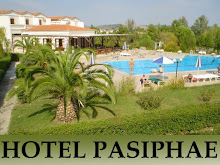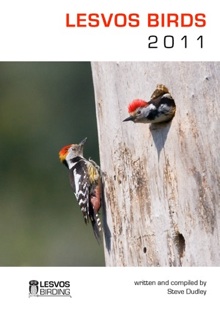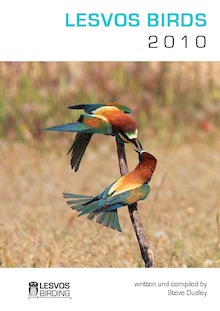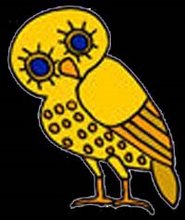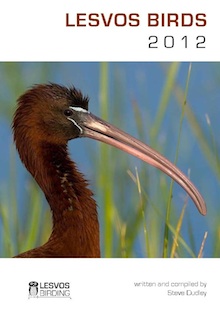Lesvos Birding holidays
See here for available 2009 dates.
See here for available 2010 dates.
Whats included in your holiday? Click here to find out!
Max group size 7 participants.
2010 prices
Tour cost: £750 per person (excluding flight)
Deposit: £200
Single supplement: £50
Please read Lesvos Birding tour terms and conditions.
Private groups
I offer a variety of services for private groups:
Full tour: you can either book one of the above weeks for your hole group or I will lead your group around Lesvos for the period of your choice. If your group is over 7 participants, one or more of the group organisers can opt to be driver(s) of the second vehicle.
Itinerary: I can help you plan your trip itinerary.
For previous trips see here.
Note: Speyside Wildlife holidays are booked via them and are subject to their own pricing and terms and conditions. Lesvos Birding supplies the services of Steve Dudley as head guide for Speyside Wildlife Lesvos holidays.
What they have said about the book!

GUIDE
TO
LESVOS
by Steve Dudley
Pim & Stuart (New Zealand)
Having just returned from 2 weeks birding in Lesvos (staying at the Pela) we would like to add our thanks to you for the sterling effort put into producing your book. Although we had visited 3 years ago, using the Brooks book, yours added considerably to our knowledge of the island and introduced us to some new sites. As the feedback that you have already come across indicates, your hard work and commitment to this project has been very much appreciated by many birders this spring.
Best Regards,
Ian & Ruth M (UK).
"I just wanted to report that we enjoyed your book very much. It is pleasantly written and was a real help to us on the island in September. . . it's very complete and recommendable." Alex V (Amsterdam, The Netherlands)
Top birding sites on Lesvos
 Pithariou monastery and reservoir, Sept 09 © Steve Dudley
Pithariou monastery and reservoir, Sept 09 © Steve DudleyClick on highlighted place names for link to Google World Map.
CENTRAL AREA
 The Gulf of Kalloni as seen form the top of Mt Lepetimnos (Jan 09). The Gulf dominates the centre of the island and is a huge funnel for migrants moving up form the south in spring. Wetland birds concentrate at the Kalloni Ssaltpans right at the centre of the Gulf's northern shore. You can just make the salptans left of centre. Down the east coast (left as we look at the photo above) lie Achladeri and the Polichnitos Salptans and down the right (west) coast Parakila and Makara. © Vasilis El. Vogiatzis / Hotel Pasiphae
The Gulf of Kalloni as seen form the top of Mt Lepetimnos (Jan 09). The Gulf dominates the centre of the island and is a huge funnel for migrants moving up form the south in spring. Wetland birds concentrate at the Kalloni Ssaltpans right at the centre of the Gulf's northern shore. You can just make the salptans left of centre. Down the east coast (left as we look at the photo above) lie Achladeri and the Polichnitos Salptans and down the right (west) coast Parakila and Makara. © Vasilis El. Vogiatzis / Hotel Pasiphae1) Skala Kallonis (pp. 97-99)
This coastal area lies on the northern shore of the Gulf of Kalloni. The Skala Kallonis Pool, when wet, is a great starting and ending point for those staying at the resort.
You can view a White Stork nest on a rooftop (at Ariana) by looking east from the Hotel Pasiphae entrance.
2) River Christou (west of Skala Kallonis - p.100)
Walking distance for those staying at Skala Kallonis, this river and marsh is good for waders, storks and herons. A viewing screen and sun shade were erected here in 2008.
3) Lower Tsiknias Valley (east of Skala Kallonis - p. 104)
 Tsiknias River - south of the Kalloni-Mytilini road bridge looking north
Tsiknias River - south of the Kalloni-Mytilini road bridge looking northAlso walking distance from Skala Kallonis. The lower section of this river, with its south-facing mouth, is a great migrant trap. Waterbirds include marsh terns, waders, crakes, herons, storks, ibis etc. The scrubby banks can be full of warblers and Spanish Sparrows, and the adjoining fields and field boundaries great places to look for chats, shrikes, buntings and raptors. Bee-eaters breed along the river.
4) Upper Tsiknias Valley (west of Kalloni - p. 104)
This area lies north of the Kalloni-Mytilini main road, and as you get further away form the river mouth, the frenetic pace of migration slows. The areas either side of the bridge are were good for waders and herons, and further upstream, contintue to search for warblers and wagtails.
5) Potamia Valley, river mouth and reservoir (p. 100)
 This is another north-south valley west of Kalloni and Skala Kallonis. Great for passage migrants. In spring, the area around the the Kalloni-Parakila road bridge is good for waders and herons. Upstream, the area around the weir and to the south is good for migrant passerines and Olive-tree Warbler can occur in this area from May. The man-made reservoir is always worth checking. It usually holds Little Grebe, Black-necked Grebe in winter, and during the summer always attracts many species to drink. Rare finds such as Spur-winged Plover have occured here.
This is another north-south valley west of Kalloni and Skala Kallonis. Great for passage migrants. In spring, the area around the the Kalloni-Parakila road bridge is good for waders and herons. Upstream, the area around the weir and to the south is good for migrant passerines and Olive-tree Warbler can occur in this area from May. The man-made reservoir is always worth checking. It usually holds Little Grebe, Black-necked Grebe in winter, and during the summer always attracts many species to drink. Rare finds such as Spur-winged Plover have occured here.6) Metochi Lake (p. 102)
This lake is actually a widening of the Christou River north of the Christou River road bridge and west of Kalloni (marked on most maps). It is one of the top sitesin spring and is fantastic for crakes (all three species), Night-heron, Purple Heron, Little Bittern, marsh terns, warblers, hirundines. The channel which runs up the west side of the lake is always worth checking, especially the north end by the little bridge. The surrounding area is also worth searching and often holds shrikes and chats (especially in autumn). There is a circular route around the lake (see local maps). The lake rarely ever dries out completely and even in late summer and autumn can still hold waders and the odd Kingfisher, as well as attracting many species down to drink.
7) Kalloni Saltpans (p. 108)
 This is a large area east of Kalloni and the Tsiknias River. It lies at the north of the Gulf of Kalloni and is a major draw for many wetland and open country migrant species. The pans themselves attract all wetland species - waders, gulls, terns, herons, storks, wildfowl and the rare species such as pelicans. The surrounding open fields and seasonal pools (Alykes Wetlands) attract grassland and open country species including many raptors (inc. Montagu's and Pallid Harrier, Red-footed Falcons), Collared Pratincole, Stone-curlew, Quail, etc. The season pools near the works entrance can be fantastic for migrant waders and marsh terns.
This is a large area east of Kalloni and the Tsiknias River. It lies at the north of the Gulf of Kalloni and is a major draw for many wetland and open country migrant species. The pans themselves attract all wetland species - waders, gulls, terns, herons, storks, wildfowl and the rare species such as pelicans. The surrounding open fields and seasonal pools (Alykes Wetlands) attract grassland and open country species including many raptors (inc. Montagu's and Pallid Harrier, Red-footed Falcons), Collared Pratincole, Stone-curlew, Quail, etc. The season pools near the works entrance can be fantastic for migrant waders and marsh terns.
 Season pools by the saltpans attracts many waders, herons and marsh terns on passage
Season pools by the saltpans attracts many waders, herons and marsh terns on passageTwo hides have now been erected overlooking the saltpans. One in the north-east corner off the main Kalloni to Mytilini road, the other along the Saltpans access road just west of the Saltworks entrance.
The adjacent Alykes Wetlands (sheep fields) are also excellent for grassland species such as Short-toed Lark, Red-throated and Tawny Pipits. The seasonal pools here also attractmany waders and herons.
8) Other Kalloni area sites
a. Madaros (dead goat pit track - p. 115)
This area lies to the west of the upper Tsiknias River and is a good area for Rufous Bush Robin from early May.
b. Kalloni Raptor Watchpoint (the Kalloni bandstand - p. 117)
Situated north of Kalloni on the road to Petra. Look for the 'bandstand' structure on one of the higher hairpins. A great raptor watch point in spring and also good for passerine migrants such as Ortolan Bunting and Ruppell's Warbler.
c. Kalloni mini soccer pitch (Scops Copse - p. 115)
The 'Scops Copse' lies just north of Kalloni just past the turn to Sigri. The trees here usually holds roosting Scops Owl and have had breeding Long-eared Owl.
9) Napi Valley (p. 120)
 The Napi Valley runs north through the centre of the island, from the Kalloni saltpans right up to Mandamdos in the north of the island. It is a major migrant passage route, and one of the main cross-island routes for raptors and other large migrating birds.
The Napi Valley runs north through the centre of the island, from the Kalloni saltpans right up to Mandamdos in the north of the island. It is a major migrant passage route, and one of the main cross-island routes for raptors and other large migrating birds.Look for the White Stork nest on a chimney on southern outskirts (west side of road) of Agia Paraskevi.
 White Stork nest at Agia Paraskevi
White Stork nest at Agia Paraskevi
a. Napi (p. 120)
Just south of the village of Napi is a track on the east side of the road. This is a good area to search for breeding Goshawk, Long-legged Buzzard, Short-toed Eagle, Sombre Tit and Middle Spotted Woodpecker. Also good views to look for migrating raptors.
b. Koriani (p. 120)
North of Napi, this area overlooks a large hill on the east side of the valley and is an excellent view point for migrating raptors.
c. Platania (p. 120)
At the top of the valley, there is a track which runs due south (not far from the west track to the masts). This is a long track across the top of the Napi Valley and a great vantage point in spring to look for raptors which come straight at you and over your head. The walk down a few kilometers, to a cattle grid, is very good for Olive Tree Warbler. The cattle grid area, and just north of it down the slope, is the best area ot search.
10) Mesa Wetlands (p. 164)
This area lies between Kalloni Saltpans and Achladeri. The large rocky outcrop coined the rather stupid name of 'Derbyshire' among birders. The rock holds Rock Nuthatch and occasionally Blue Rock Thrush. In winter and spring the large seasonal pool here is very good for herons, egrets, storks, waders and Ruddy Shelduck.
11) Achladeri Forest (p. 168) 'The' Krüper's Nuthatch site on the island is the woodland area south of the main coastal road before the buildings and army camp of Achladeri. Park by the white-washed building and walk through the wood. Short-toed Treecreeper, Masked Shrike, Woodlark and Black-eared Wheatear all breed here. The large wooded hill rising above the car park can be good for raptors.
'The' Krüper's Nuthatch site on the island is the woodland area south of the main coastal road before the buildings and army camp of Achladeri. Park by the white-washed building and walk through the wood. Short-toed Treecreeper, Masked Shrike, Woodlark and Black-eared Wheatear all breed here. The large wooded hill rising above the car park can be good for raptors.
THE SOUTH
12) Achladeri to Skala Polichnitou (inc Alikoudi Pool - p.169)
Just after Achladeri camp, turn right and on to the coast track. Stop to check fields, streams etc. Look for Olive-tree Warbler and Middle Spotted Woodpecker in the olive grove areas. The Alikoudi Pool lies just north of the village of Skamnioudi north of the saltpans. It is marked on maps. Access from inland track to the south of the pool, a track leads to the east end of the pool. the coast tracl should only be tackled with care and a 4x4 id really needed.
13) Polichnitos Saltpans (p. 171)
Sutuated on the east side of the Gulf of Kalloni, for some reason these saltpans come in to their own in autumn. Much smaller and much easier to view than the Kalloni Saltpans, you can search the whole area on foot around the perimeter. Great for waders, herons, egrets, storks, gulls, terns. The surrounding area (in particular the ridge to the east) is excellent for migrant raptors.
14) Skala Polichnitou to Vatera
Stop at river bridges and ridges. In spring and autumn good for raptors and larger migrant birds passing over.
There is a White Stork nest on a chimney in Polichinitos.
15) Vatera area inc. Agios Fokas (p. 174)
This area lies south-east of the mouth of the Gulf of Kalloni. The main areas to search are the Almiropotamos River bridge to the west of the resort and the track down to the headland of Agios Fokas. Avoid using optics and cameras around the army base just north of the headland. A great area for passage migrants, including raptors. Expect shearwaters off the headland, as well as spotting birds such as raptors, herons and waders coming in off the open sea. Sardinian Warbler (a difficult species to see on Lesvos) occurs in small mumbers on this peninsular.
16) Ambeliko Valley (Kata Stavros to Ambeliko - p. 178)
A little known valley east of Vatera running north along the western side of Mount Olympus range. Good for overhead migrants including raptors. Olive Tree and Sardinian Warblers occurs in several places.
17) Agiasos to Plomari (east of Mount Olympus - 180)
The area just north of the Agaissos Sanitorium is good for Krüper's Nuthatch. A little further along at the top of the ridge, very good for Eastern Bonelli's Warbler (breed here - hear them singing but can be difficult to see), Serin, and commoner woodland species rare elsewhere on the island such as Robin, Mistle Thrush, Wren, etc. The valley south to Plomori, especially around Megalochori, is also good inc. Eastern Bonelli's Warbler.

Mixed woodland above Agiasos
18) Around Gera Gulf (inc Dipi Larssos - p. 184)
Good for typical reedbed and wetland migrants.
THE EAST
19) The Mytilini peninsular (p. 186)
The area around the island's capital is a little watched area but a good area, particularly south of the airport, for migrants and breeding Sardinian Warbler. Cape Lena south of the airport is good for looking for Scopoli's Shearwater.
At the south of the peninsular is Haramida Marsh. This is a difficult site to work in spring when its sometimes impossible to view the pools surrounded by tall reeds. In autumn the site is dry but still attracts many migrants and Sardinian Warbler occurs here year-round.
20) Mytilini to Mandamados
North of the capital. Another little watched area. Not especially noted for migrants, but one of the few areas on the island for breeding Sardinian Warbler and Ruddy Shelduck around Palios.
Look for the White Stork nest on a chimney on the northern outskirts of Mandamados.
THE NORTH
21) Anaxos area
This north coastal area of the island is little watched and can be good for migrants and passage raptors.
22) Petra and Molivos (p. 124-6)
North of Kalloni on the north coast. The main area on the island for Rüppell's Warbler. Search the scrubby areas north of Petra at Kavaki, just north of the 'disco' building which looks like something out of Thunderbirds! The layby just above this building is the best place to search. The layby looks down over the Bay of Kavaki and Cape Kavaki (headland) and up across the road to the hillside (Rachona Hill). Both excellent for Rüppell's. Also excellent for migrants.
 Kavaki, the Rüppell's Warbler site north of Petra looking across to Cape Kavaki and across to Turkey
Kavaki, the Rüppell's Warbler site north of Petra looking across to Cape Kavaki and across to Turkey
The reservoir at Perasma is again in use and attracts many waterbirds. Black-nekced Grebe can often be seen here in autumn and winter, Ruddy Shelduck bred here in 2009 and the whole area is good for migrants. River Warbler has been recorded here on several occasions.
23) Molivos to Skala Sikaminias (p. 28)
Molivos can be a good raptor view point in spring and autumn. Have lunch here at one of the many excellent harbourside tavernas!
Follow the road east through Efthalou (check the sea for shearwaters and dolphins) and then follow the coastal track east to Skala Sikaminias. The valleys aong this coast can be excellent for migrants. Raptors can be good and it is one the best areas to see Audouin's Gull (inc. around the harbour village of Skala Sikaminias). Can also be very good for butterflies including Cleopatra.
 North-facing, steep sided, scrub- and tree-lined little valleys are great for migrants in spring and autumn
North-facing, steep sided, scrub- and tree-lined little valleys are great for migrants in spring and autumn The beautiful little harbour village of Skala Sikaminias
The beautiful little harbour village of Skala Sikaminias The olive-groved hillsides west of Sikaminias looking north towards Turkey (just visible in distance)
The olive-groved hillsides west of Sikaminias looking north towards Turkey (just visible in distance)24) Petra to Kila – inland via Stipsi and Pelopi below Mount Lepetimnos (p. 132)
An excellent area in spring and autumn to look for migrant raptors.
25) Mount Lepetimnos area (p. 132)
Try the track to the summit between Sikamina and Kilo up to Vigla. Exellent area to search for migrants and raptors.
THE WEST
26) Skala Kallonis to Eresos
The drive west through the south-west of the island on the Kalloni to Eresos Road.
a. Parakila Marsh (p. 138)
West of Skala Kallonis the marsh lies just before (northeast) of the village of Parakila along the coastal road. This is an increasingly poor area and now little watched. Still worth checking if you have time as you pass though. The hide erected here in 2008 was accidentally burnt down in early 2009 (not arson as the rumours had it!).
b. Aghios Ioannis (p. 139)
 From the road looking north up the gulley towards the chapel gulley. You can walk up to the chapel to view
From the road looking north up the gulley towards the chapel gulley. You can walk up to the chapel to viewAn excellent gulley about 1km west of Parakila. Holds breeding Cinereous Bunting, Rock Nuthatch, Black-eared Wheatear and Sombre Tit. Also good for migrants.
 From the road looking south towards Krakala harbour
From the road looking south towards Krakala harbourc. Makara (p. 140)
14 km south-west of Parakila, Makara forms the the western headland at the mouth of the Gulf of Kalloni. A great coastal migrant area, particularly in spring when the river ford by the beach is wet, and the small pools also attracts migrants. The valley just before you reach the coastal area is worth looking through from the track for shrikes and other migrants. The offshore island of Garbias holds a colony of Lesser Kestrels plus pucka Rock Doves!
d. Agra and Mesotopos (p. 142-44)
The 'two towers' above Agra is an excellent stop, and like the valley sides and ravines west towards Mesotopos, holds breeding Rock Sparrow and Cinereous and Cretzschmar's Buntings, and the area can be good for raptors incl. Eleanora's Falcon.
e. Chrousou (south of Mesotopos - p. 145)
Ignoring Tavari, take the track west just north of the village west to Chrousou. Great for migrants, including autumn when the valley bottom is highly irrigated and therefore lush and green.
27) Pithariou Reservoir (near Eresos - p. 160)

The largest freshwater body on the island. Just 1km along the Eresos to Mesotopos road (from Eresos), turn north at the river bridge (on the east side) and follow the river track to the dam. Holds water all year round and therefore good for birds at all times, but particularly good in summer and autumn when there are few areas of standing freshwater on the island.
28) Skala Eresou (south of Eresos - p. 162)
The river bridge/old ford area is good in spring and autumn (when it is still often wet). Herons, waders, warblers and wagtails. Check the sea for shearwaters here - both species occur. The beach to the west of the river mouth can be worth exploring and can be good for arriving Stone-curlew and Quail.
29) Meladia Valley (between Sigri and Eresos - p. 156)
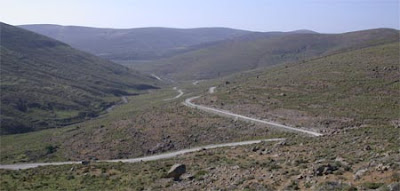 This is a great, 16km cross-country track through open country. Allow 30 mins for a straight drive from either end to the Meladia River Ford (takes much longer with regular stops).
This is a great, 16km cross-country track through open country. Allow 30 mins for a straight drive from either end to the Meladia River Ford (takes much longer with regular stops).In Eresos their is a White Stork nest on a back yard telegraph pole in the centre of the town.
a. Eresos to Meladia River Ford (p. 156)
Open country good for Cretzschmar’s and Cinereous Buntings, Rock Nuthatch and Chukar.

b. Meladia River Ford area (p. 156)
In spring the river ford is a major migrant trap. It sits inland of the coast with pols either side of the track. Anything can turn up here and in the surrounding area. Rufous Bush Robin breeds in the surrounding scrub. The fig grove just north of the ford is excellent for warblers, flycatchers and shrikes.
c. Meladia River Ford to Sigri (p. 156)
Open country good for Cretzschmar’s Bunting, Rock Nuthatch, Chukar, raptors including Lesser Kestrel and Eleanora's Falcon.
30) Kalloni to the Lardia Valley (p. 135)
Look out for overhead raptors on your drive across to the west of the island on the Kalloni to Sigri road. The open, barren area just out of Dafia is good for Stonechat and Rock Nuthatch.
31) The Lardia Valley (west of Vatousa - p. 137)
 This deep gorge-like valley between Vatousa and Andissa is good for migrants and raptors. Crag Martin and Rock Sparrow breed, and Eastern Bonelli's Warbler held territory here in 2008 and again in 2009.
This deep gorge-like valley between Vatousa and Andissa is good for migrants and raptors. Crag Martin and Rock Sparrow breed, and Eastern Bonelli's Warbler held territory here in 2008 and again in 2009.32) Vigla (p. 147)
This is the area just west of the Eresos/Sigri road juntion (look for triangle of roads on maps), heading towards Ipsilou and Sigri. It is a great area for Isabelline Wheatear, Cinereous Bunting and Rock Sparrow, and can also be very good for migrants including raptors.
33) Ipsilou Monastery (p. 147)
 Ipsilou lies c.11km east of Sigri - you can't miss it! One of the top migrant areas on the island in both spring and autumn. The trees on the mount slopes can be dripping with warblers and flycatchers during good falls, and the top of the mount is a great place to watch passing swifts (including Alpine and Pallid) and raptors which are often at eye level or even below! Breeding brids include Rock Sparrow, Cinereous Bunting, Isabelline Wheatear, Sombre Tit. Can be a good area for Chukar.
Ipsilou lies c.11km east of Sigri - you can't miss it! One of the top migrant areas on the island in both spring and autumn. The trees on the mount slopes can be dripping with warblers and flycatchers during good falls, and the top of the mount is a great place to watch passing swifts (including Alpine and Pallid) and raptors which are often at eye level or even below! Breeding brids include Rock Sparrow, Cinereous Bunting, Isabelline Wheatear, Sombre Tit. Can be a good area for Chukar.Park at the bottom before the road up to the monastery and walk! Take your lunch and water with you and don't thnk of returning in under two hours unless it is deathly quiet! This site can easily occupy 4+ hours to a whole day on a good fall day. Exceptional falls can occur, such as that on 27 Apr 08 when the whole place was covered in birds!
 View north-west from top of Ipsilou
View north-west from top of Ipsilou34) Ipsilou to Sigri (p. 150)
This area can be outstanding for falcons. Lesser Kestrel and Eleanora's Flacon are believed to breed on the offshore islands off Sigri, and flocks often patrol the hillsides on this side of the island. During spring passage these flocks can also hold Red-footed Falcon and Hobby.
 The view down to Sigri approaching from Ipsilou
The view down to Sigri approaching from Ipsilou35) Sigri Fields (p. 151)
The fields just north of Sigri are a great migrant passerine area and another area for hunting falcons and harriers.
36) Faneromeni (p. 151)
Faneromeni is the area through which the Tapas River flows west to the sea north of Sigri (beyond Sigri Fields).
a. Faneromeni Fields (p. 151)
The fields either side of the Tapas River are great for migrant passerines and another area for hunting falcons and harriers.
 The fields above the river ford are worth checking
The fields above the river ford are worth checking
b. Faneromeni river mouth (p. 151)
In spring, when wet, always worth checking for waders and migrant passerines.
c. Faneromeni upper river ford area (p. 151)
A favourite lunch spot for many, this river ford is a magnet for migrant passerines including rare flycatchers.
Faneromeni upper ford - here the river has been canalised in recent years, and although the bankside scrub and vegetation soon regenerated, the edges of the river lots its nooks and crannies. It is still an outstanding place for terrestrial and riparian migrants.
 Faneromeni lower ford lies about 1/2km inland of the river mouth and is equally good as the upper ford for migrants inc. Night-heron and Little Bittern.
Faneromeni lower ford lies about 1/2km inland of the river mouth and is equally good as the upper ford for migrants inc. Night-heron and Little Bittern.Lesvos trip report 21 July - 4 August 2007
Robin's pictures here
Accommodation - Villa Vasso, Skala Kallonis
Weather - warm, 31-35 degrees, steady breeze most days, quite windy in highlands.
SPECIES LIST
For species status see here
For stie information see here
Little Grebe, Evidence of breeding with young birds at Kalloni inland lake. 20+ birds at Kalloni res on 2/8 and single bird on roadside pool at turning to Apothika from road to Agra.
Cormorant, Eight birds at Kalloni res on 2/8, probably the same birds flying across Kalloni bay a fe evenings before.
Shag, Single bird seen in the bay between Petra and Molyvos on 25/7.
Little Bittern, Single adult male bird photographed at Kalloni inland lake and first seen on 23/7 early morning.
Night-heron, Two adult birds seen early mornings at Kalloni inland lake and first seen on 23/7
Little Egret, Several birds seen (max 5 together) at Kalloni Salt Pans. Also single bird at Polichnitos.
Grey Heron, Several birds present daily at Kalloni Salt Pans and Inland Res.
Black Stork, Birds frequently seen around Kalloni area. Max of 13 birds including young birds seen in Derbyshire area on 25/7.
White Stork, Breeding pair with four young at Skala Kallonis. Also bird at nest in Polichnitos.
Greater Flamingo, Estimated 200+ at Kalloni & Polichnitos Salt Pans.
Ruddy Shelduck, Max count of 22 seen on several occasions between Kalloni Salt Pans and Derbyshire pools.
Common Shelduck, Single adult bird seen with Ruddy Shelduck on 21/7 and 28/7.
Short-toed Eagle, Common throughout the island and seen daily. Bird frequenting Kalloni bay area on a number of occasions.
Goshawk, Single adult bird on the ground at Kalloni inland res on 2/8, possibly injured ?
Eurasian Sparrowhawk, Single adult bird seen near Petra res. on 27/7.
Common Buzzard, Total of five birds including family party of three seen near Pelopi on 27/7
Long-legged Buzzard, Bird seen close to Kalloni Salt Pans on 23&24/7 but otherwise not seen elsewhere!!
Lesser Kestrel, Two birds seen at Faneromeni on 23/7
Common Kestrel, Single bird seen at Kalloni Salt Pans on 21/7
Lanner ??, Possible birds seen over Petra on 25/7 and another between Parakila and Agra on 28/7. Neither bird seemed bulky enough to be Peregrine although firm ID not made.
Peregrine, Family group seen well from site near Achladeri on 30/7.
Chukar, Birds heard but not seen from Petrified Forest on 26/7
Moorhen, Young birds at Kalloni Inland Lake
Black-winged Stilt, Family including four young birds at Kalloni Inland Lake. Common at salt pans.
Avocet, 50+ birds at Kalloni Salt Pans
Little Ringed Plover, Birds common at Kalloni Salt Pans and Kalloni Inland Lake. Young birds present.
Kentish Plover, Birds at Kalloni Salt Pans including juveniles.
Little Stint, Max of six birds seen at Kalloni Salt Pans. Birds present throughout.
Temminck’s stint, First bird seen at Kalloni Inland Lake on 28/7, then probably same bird at Kalloni Salt Pans from 29/7.
Curlew Sandpiper, Single first-year bird seen at Kalloni Salt Pans on 21/7
Spotted Redshank, Single bird seen in Derbyshire area on 30/7
Greenshank, Birds seen throughout at Kalloni Salt Pans and Kalloni Inland Lake. Max of six birds seen at Derbyshire on 30/7.
Green Sandpiper, Two birds at Kalloni Inland Lake throughout.
Wood Sandpiper, 10+ birds at Kalloni Salt Pans on 21/7. Numbers then dropped with birds seen at Salt Pans and Kalloni Inland Lake.
Common Sandpiper, Single bird seen at Kalloni Salt Pans on 27/7 and on East River on 1/8
Black-headed Gull, Common around Kalloni bay and East River.
Yellow-legged Gull, Common around Kalloni bay and East River.
Gull-billed Tern, Single adult bird seen fishing in Skala Kallonis Harbour on 3/8
Common Tern, Common around Salt pans and East River including family of four young birds at river mouth.
Little Tern, Common around Kalloin Salt Pans
Rock Dove, Single bird seen from Petrified Forest on 26/7
Collared Dove, Common throughout island.
Turtle Dove, Birds including young seen most days around Kalloni area.
Little Owl, Birds seen at Villa Vasso, Petrified Forest, Derbyshire and Napi Valley
Common Swift, Birds over Kalloni Inland Lake on 23/7
Kingfisher, Single bird seen at Kalloni Inland lake on 1/8 & 2/8
Bee-eater, Groups of birds seen daily including 10+ around East River , Petra Res and Perivolis Monastary.
Hoopoe, Birds seen around Kalloni Inland lake, Napi Valley and other locations although not numerous.
Middle Spotted Woodpecker, Single bird seen from road-side near Achladeri.
Crested Lark, Abundant !
Crag Martin, Birds seen from road beneath Yipsilou Monastery
(Common/Barn) Swallow, Common around Skala Kallonis
Red-rumped Swallow, 10+ birds frequenting Kalloni Salt Pans
House Martin, Common around Skala Kallonis
Yellow Wagtail, Birds absent until 1/8 when first migrants seen at East River – probable thunbergi
White Wagtail, Single birds seen at Kalloni Salt Pans
Rufous Bush Robin, Obliging pair seen daily in field adjacent to Villa Vasso. Frequent along tracks toEast River and Salt Pans
Common Nightingale, Single burst of song heard near Kalloni Inland Lake on 23/7. No birds seen however.
Stonechat, Single bird seen from roadside between Eressos and Sigri
Isabelline Wheatear, 2-3 birds seen from roadside immediately west of junction of Eressos and Sigri road.
Northern Wheatear, Birds seen along roadside between Eressos and Sigri.
Black-eared Wheatear, Birds of both forms seen throughout the island.
Blue Rock Thrush, Single bird seen from Devil’s Bridge, Parakila.
Blackbird, Common around Skala Kallonis Inland Lake
Cetti’s Warbler, Common around Inland Lake
Reed Warbler, Common around Inland Lake
Great Reed Warbler, Single burst of song and seen well on 21/7 at ford of East River
Eastern Olivaceous Warbler, Birds seen daily being common in Tamarisk bushes.
Eastern Subalpine Warbler, Birds seen throughout around Petra, Molyvos and Kalloni Inland Lake
Eastern Orphean Warbler, Birds seen at Molyvos, Devil’s Bridge and roadside pool near turn to Apothika.
Ruppell’s Warbler, Family party at layby between Petra and Molyvos with Juvenile photographed . 27/7
Common Whitethroat, Single bird seen from roadside beneath Yipsilou Monastery
Long-tailed Tit, Feeding party including juveniles in pine trees near Achladeri
Sombre Tit, Birds seen at Devil’s Bridge, Kallonia Inland lake, near Ypsilou Monastery and near Pelopi.
Blue Tit, Common and seen most days.
Great Tit, Seen most frequently in the North of the Island.
Kruper’s Nuthatch, With patience, seen well at regular site near Achladeri on 29/7 and 30/7 after earlier visits had been thwarted by army presence. Four birds seen in feeding party on 30/7.
Western Rock Nuthatch, Seen daily. Bird common in most upland locations.
Short-toed Treecreeper, Single bird seen at site near Achladeri on 29/7.
Lesser Grey Shrike, No sightings until adult bird seen opposite Villa Vasso apartments on 2/8.
Woodchat Shrike, Common and seen daily at most locations. Most birds seen being first year birds.
Masked Shrike, Birds seen in Olive groves close to Kalloni Inland Lake and at various sites in Napi Valley.
Jay, Birds common both in the north around Petra and Molyvos and in wooded areas elsewhere.
Hooded Crow, Birds common throughout island.
Raven, Birds seen at Devil’s Bridge, Napi valley near refuge tip close to Madamados and in western highlands.
House Sparrow, Abundant.
Rock Sparrow, Birds heard and seen briefly at junction of Eressos and Sigri road.
Chaffinch, Birds seen at various locations during the fortnight
Greenfinch, Birds seen at various locations during the fortnight including East River
Goldfinch, Birds common throughout island
Linnet, Group of birds drinking at East River ford most days.
Serin, Single first-year bird seen near East River on 22/7
Cirl Bunting, Birds seen at Kapi on 27/7, near Achladeri on 30/7 and Kalloni Inland Res on 2/8.
Cretzschmar’s Bunting, Birds most common around East River and pools early morning and evenings throughout.
Species, Birds Recorded
Black-headed Bunting, 20+ First year birds seen at Faneromeni on 23/7 and single birds seen drinking in evenings at East River. No full-plumaged males seen during the fortnight.
Corn Bunting, Flock of 30+ birds frequenting fields adjacent to track to Kalloni Inland Lake.
Total = 94 + 2 heard only + 1 possible (Lanner)
Other species claimed by other birders during same period:Black-necked Grebe x2 at Kalloni Inland res
Slender-billed Gull at Polichnitos Salt pans
Mediterranean Gulls at East River mouth and Polichnitos Salt pans
Whiskered Terns x 4 at East River mouth on 21/7
Ortolan Bunting – I scrutinized birds I saw but all noted as first-year Cretzschmar’s Buntings
Alpine Swift
Stone-curlews at Kalloni Salt Pans on 21/7
Cinereous Bunting at Petrified Forest at 6pm on 20/7 – seen by two Danish Birders.
Birds looked for but not seen:
Bonelli’s Eagle around Mt Leptimnos
Olive Tree Warbler near Skalochori and Napi Valley
Cinereous Bunting at numerous sites around Sigri, Eressos, Mesotopos, Agra and Devil’s Bridge with road-side stops between.
Spanish Sparrow ?? Are they present during the summer months ?


